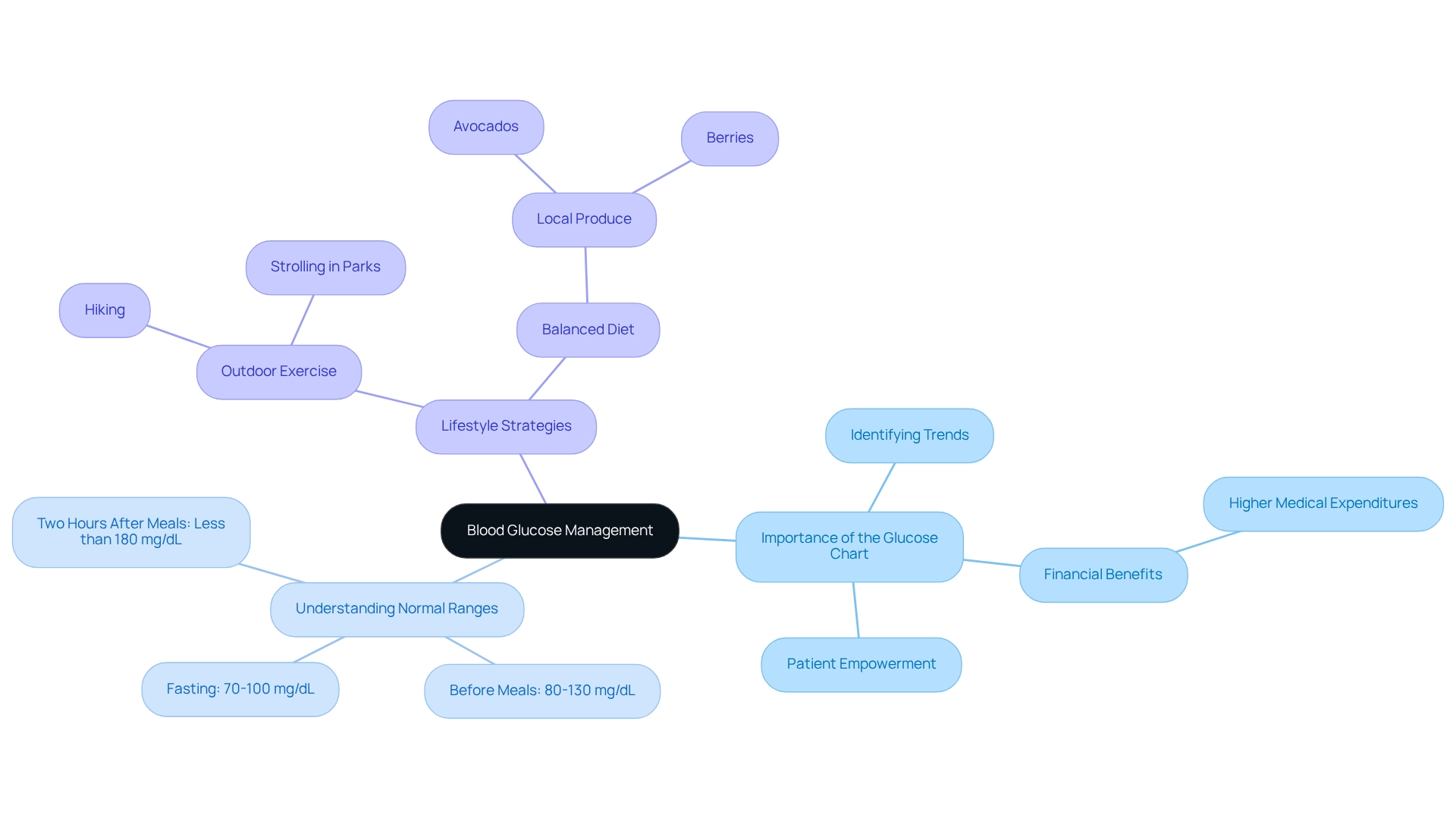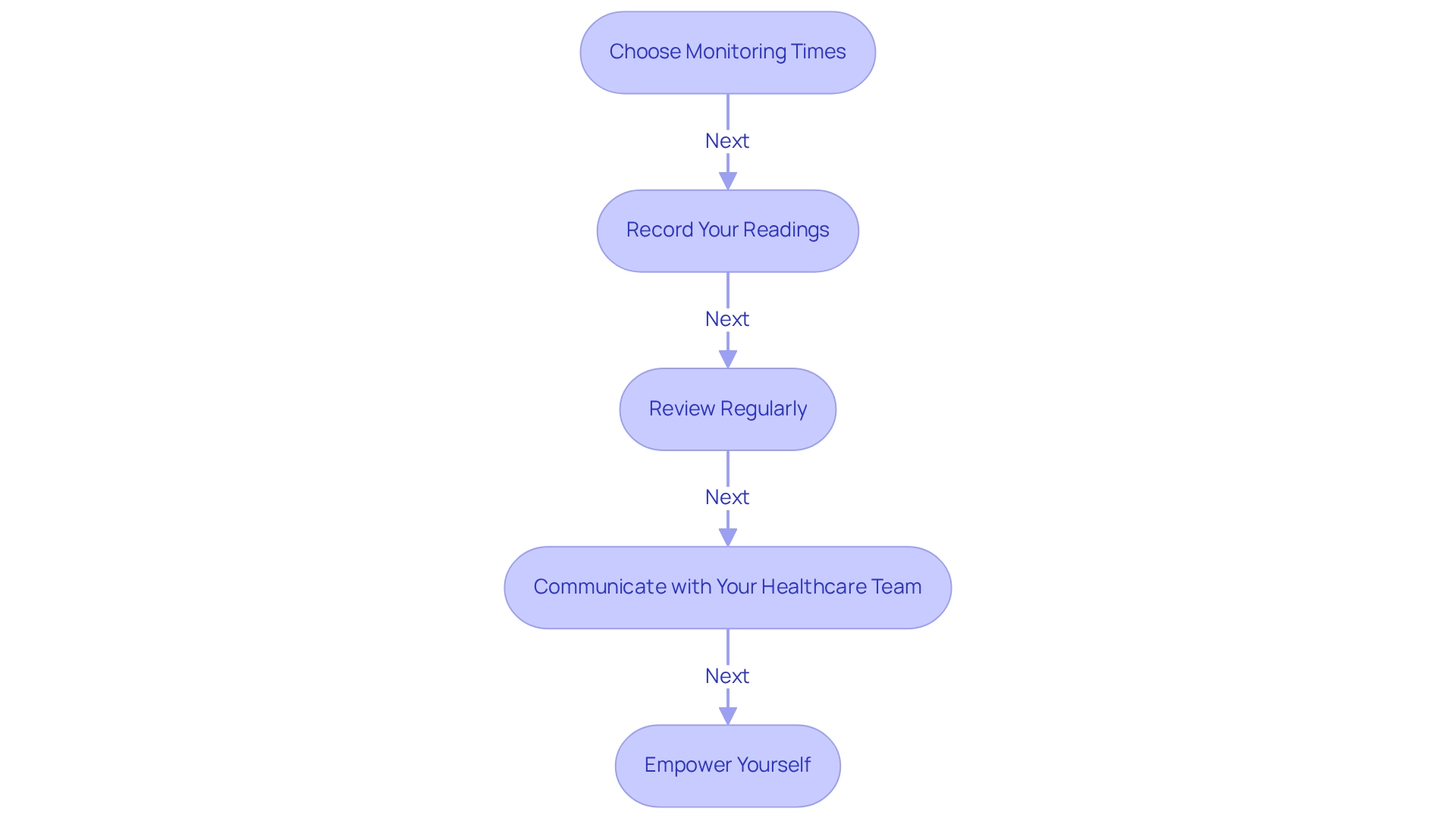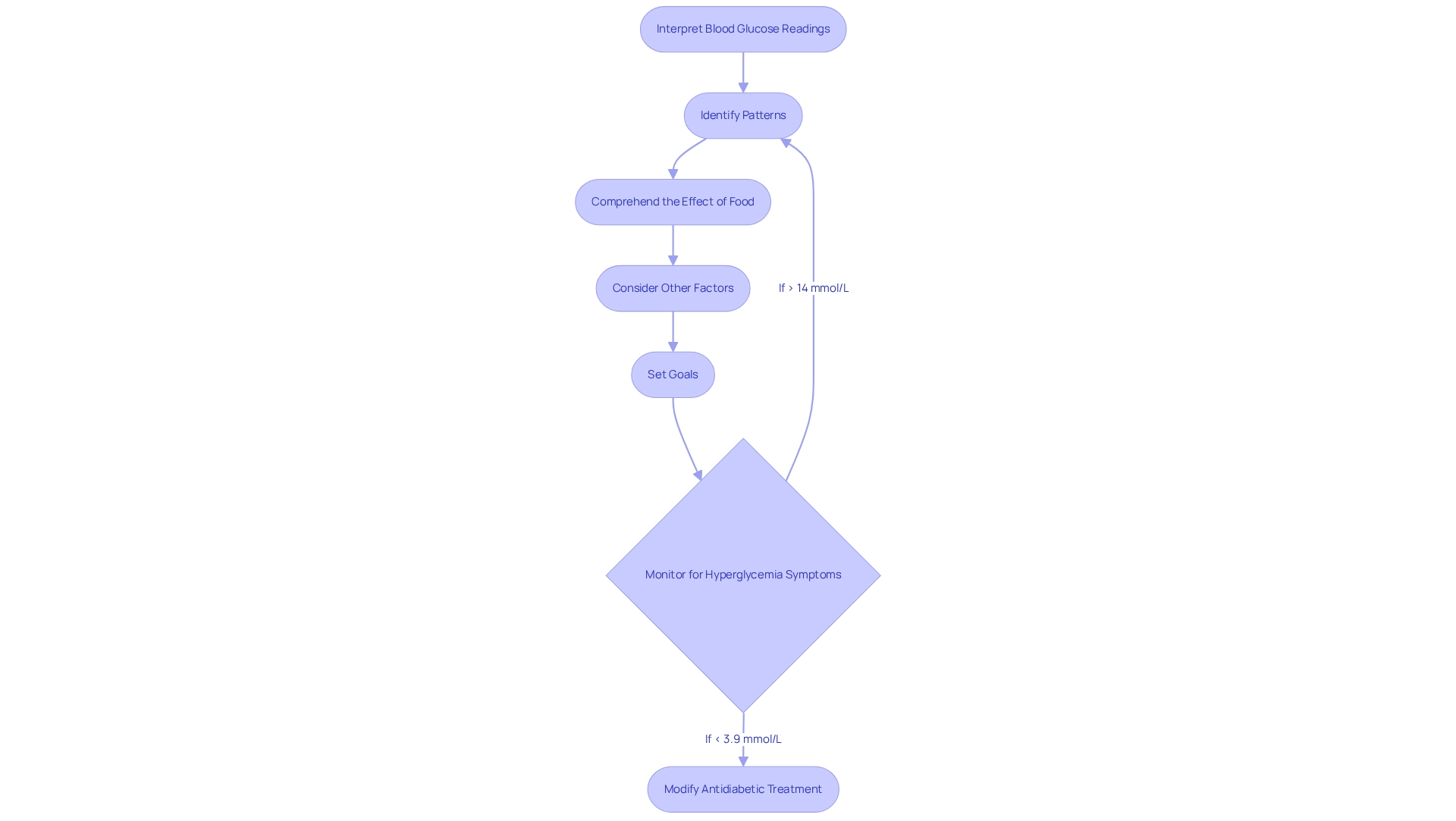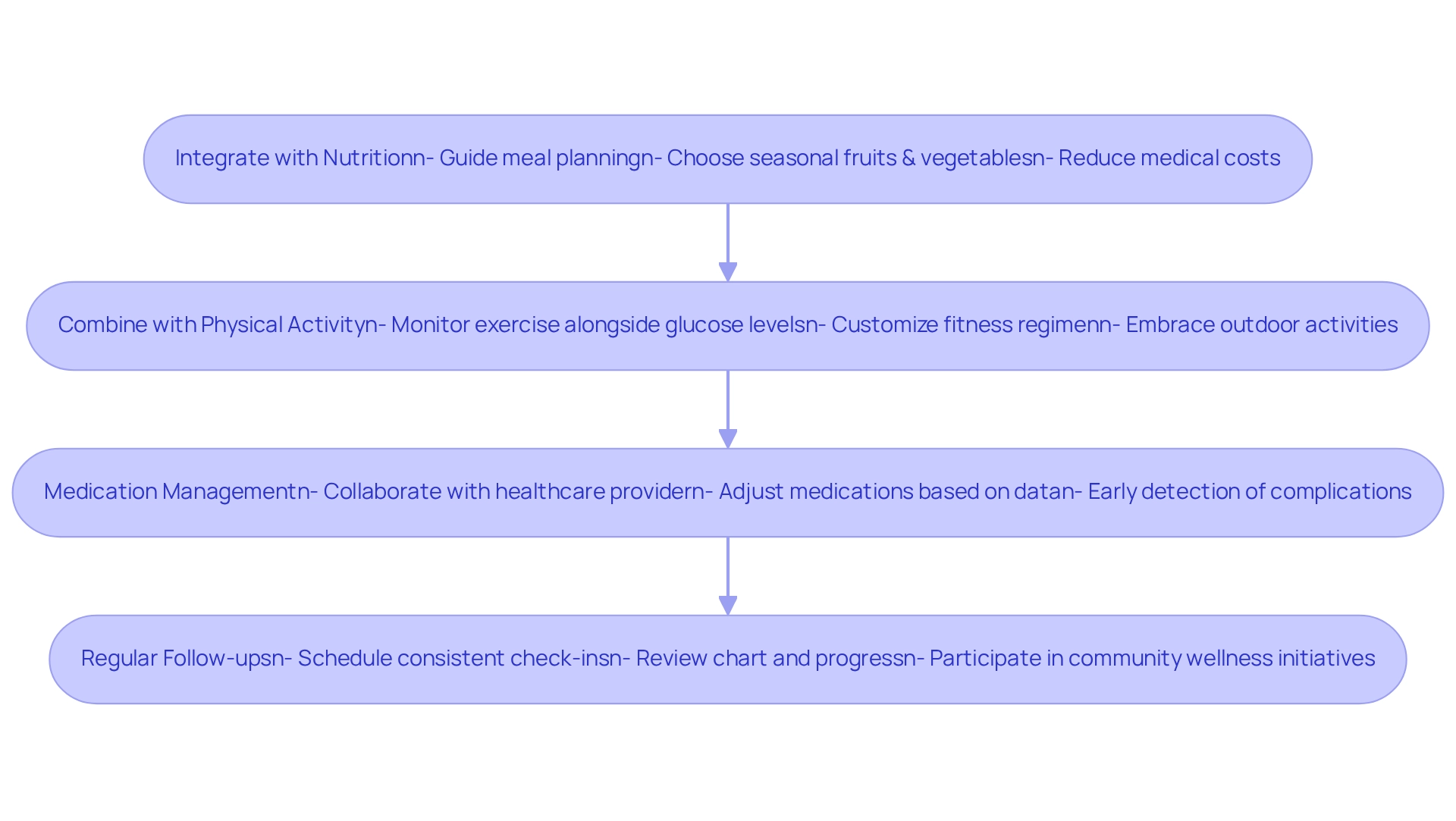Overview
Managing diabetes can be a challenging journey, and it’s essential to master the blood glucose chart. This tool plays a crucial role in tracking your glucose levels, understanding how meals impact your body, and recognizing lifestyle factors that may influence your health. By consistently recording and analyzing your glucose readings, you can identify patterns that help you make informed adjustments to your diet and exercise routine.
Many patients find that this proactive approach leads to better health outcomes and can even reduce medical costs associated with diabetes. It’s important to recognize that each small step you take toward understanding your body can make a significant difference. Imagine the empowerment that comes from knowing how your choices affect your glucose levels.
As you navigate this process, remember that you’re not alone. Many individuals share similar struggles, and by connecting with others and sharing experiences, you can foster a supportive community. Together, we can encourage each other to embrace healthier habits and work toward a brighter future.
Consider starting your journey with the 30-Day Diabetes Reset program, designed to provide you with the tools and support you need. Your health is worth the investment, and every small change can lead to meaningful results. Let’s take this journey together, one step at a time.
Introduction
In the journey of managing diabetes, it’s important to recognize that understanding and effectively utilizing a blood glucose chart can truly be a game changer. This vital tool empowers individuals to keep track of their blood sugar levels, offering insights that can lead to healthier lifestyle choices and proactive health management. Many patients find that by mastering the art of monitoring and interpreting their readings, they can identify patterns, adjust their diets, and communicate effectively with their healthcare providers.
With the rising costs associated with diabetes care, adopting a comprehensive approach that combines nutrition, physical activity, and medication management is essential. In a world where knowledge is power, this article delves into the significance of blood glucose charts and provides practical strategies to enhance diabetes management. Ultimately, this journey can lead to improved health outcomes and a better quality of life. Together, we can navigate this path toward wellness.
Understand the Blood Glucose Chart and Its Importance
Managing diabetes can be challenging, but the glucose chart can be a vital ally in your journey toward better health. This essential tool typically includes columns for recording the date, time, glucose readings, and notes about meals, medications, and physical activity. By mastering this chart, you can identify trends in your glucose levels, which is crucial for maintaining your well-being. Regular monitoring not only keeps you informed but also provides early warnings of potential issues, allowing for timely adjustments in your diet, exercise, or medication.
It’s important to recognize that understanding the normal ranges for glucose levels is vital for effective management:
- Fasting: 70-100 mg/dL
- Before meals: 80-130 mg/dL
- Two hours after meals: Less than 180 mg/dL
By familiarizing yourself with these ranges, you can accurately interpret your readings and make informed lifestyle adjustments. Recent studies suggest that effective blood glucose monitoring can significantly reduce the risk of complications related to diabetes. Moreover, average medical expenses for individuals diagnosed with the illness are 2.6 times greater than those without the condition. This highlights the financial benefits of proactive management, as efficient monitoring can lead to improved wellness outcomes and lower healthcare costs.
Many patients find that incorporating comprehensive lifestyle strategies, such as engaging in regular outdoor exercise in San Marcos, CA, can further enhance their condition management. Activities like hiking or strolling in nearby parks not only boost your physical health but also support better sugar level management. Additionally, focusing on a balanced diet rich in local produce, such as avocados and berries, can nourish your body while you manage diabetes, and real-world examples illustrate the effectiveness of blood glucose chart pdfs in diabetes care. Patients who consistently use these charts often express feeling more empowered and in control of their health, gaining actionable insights into their condition. Dr. Shumard emphasizes that by equipping patients with practical tools and education, they can reclaim their health and enhance their quality of life, ultimately reducing reliance on conventional medical interventions. Understanding how to interpret and utilize your glucose chart is a crucial step toward effectively managing your condition. Furthermore, engaging with community wellness programs can provide invaluable support and resources tailored to your diabetes management journey.
Utilize the Blood Glucose Chart for Daily Monitoring
To effectively utilize the blood glucose chart pdf, it is essential to establish a consistent monitoring schedule that seamlessly fits into your daily routine. Many patients find that having a structured approach can alleviate some of the stress associated with managing their health. Here’s how to do it:
-
Choose Your Monitoring Times: Optimal times to check your blood glucose include:
- Upon waking (fasting)
- Before meals
- Two hours after meals
- Before bedtime
-
Record Your Readings: Each time you check your glucose levels, take a moment to document the date, time, and reading in your chart. Additionally, note what you ate, any physical activity, and how you felt at that moment. This comprehensive logging can provide valuable insights into your health and help you set SMART goals—specific, measurable, attainable, relevant, and time-bound. For example, you might strive to maintain your glucose levels within a certain range or decrease your readings by a specific percentage over a month. Consider using tracking methods such as fitness apps, journals, or pedometers, and also utilize a blood glucose chart pdf to enhance your monitoring process. Remember, you’re not alone in this journey; many find that tracking their progress empowers them.
-
Review regularly by taking some time at the end of each week to analyze your blood glucose chart pdf and identify patterns. Are there specific times when your blood sugar levels are consistently higher or lower? Recognizing these trends can guide necessary modifications to your diet or activity levels, ultimately improving your overall control strategy. Frequent evaluations encourage responsibility and enable you to adjust your objectives in response to changing medical conditions.
-
Communicate with your healthcare team: It’s important to bring your blood glucose chart pdf to your appointments with your healthcare provider. Sharing this data allows for a collaborative approach to interpreting your results and making necessary adjustments to your diabetes management plan. Statistics show that 93% of doctors consider shared results sufficient for optimizing insulin doses, highlighting the significance of effective self-monitoring practices.
This aligns with the broader concept of patient empowerment in managing chronic medical conditions, which is essential for achieving improved wellness outcomes. Dr. Jason Shumard’s 30-Day Diabetes Reset program emphasizes the importance of patient education and self-monitoring, enabling individuals to take charge of their well-being. By embracing these optimal methods, you empower yourself to gain control over your condition management, resulting in enhanced well-being and an improved quality of life. As health educators often emphasize, consistent monitoring is key to understanding your body’s responses and making informed decisions about your well-being.
Interpret Blood Glucose Readings for Better Management
Interpreting glucose readings is crucial for managing diabetes effectively. Have you ever felt overwhelmed by your readings? Here’s how to analyze them in a way that feels manageable and supportive:
- Identify Patterns: Look for trends in your readings. For example, consistently elevated glucose levels after meals may indicate a need to adjust your carbohydrate consumption or medication. Recognizing these patterns can empower you to make informed choices.
- Comprehend the Effect of Food: Different foods can have varying influences on your sugar levels. Use your blood glucose chart pdf to connect specific meals to your readings, which will help you identify which foods might be causing spikes in your sugar levels. This understanding can be a game-changer in your management strategy.
- Consider Other Factors: Stress, illness, and physical activity can significantly impact glucose levels. Have you documented any major life events or changes in your routine? Keeping track of these can help you see how they correlate with your readings, providing valuable insights.
- Set Goals: Based on your readings, establish realistic objectives for your sugar levels. Collaborate with your healthcare provider to determine target ranges that align with your individual health needs. Setting achievable goals can motivate you and enhance your overall well-being.
It’s important to recognize that acute symptoms of hyperglycemia usually do not appear until sugar levels exceed 14 mmol/L (250 mg/dL). This highlights the significance of regular monitoring. Additionally, if blood sugar levels drop below 3.9 mmol/L (70 mg/dL), modifying antidiabetic treatment becomes essential. By identifying these patterns and adjusting your management strategies accordingly, you can take proactive steps toward improved well-being.
Dr. Shumard emphasizes the importance of patient education in this process. As illustrated in the case study of a patient who transformed their health through his 30-Day Diabetes Reset program, he applies his expertise in functional endocrinology and clinical nutrition to inform patients about their conditions, offering actionable insights and practical tools. This comprehensive approach not only addresses health issues but also empowers patients to take charge of their overall well-being.
As Gina Meagher aptly states, “Find the options that are right for you – for your condition, your personality, your lifestyle!” This customized approach is essential in blood sugar control, enabling you to adjust your tactics according to your specific situation.
Moreover, it is vital to acknowledge the risks associated with traditional treatments for blood sugar management. Many patients are unaware that insulin resistance can be exacerbated by the insulin injections and medications they are prescribed. Understanding that the body often struggles to utilize the insulin it produces, rather than simply lacking insulin, is crucial for effective control.
The necessity for continuous study and comprehension of your condition is paramount, as it emphasizes that managing diabetes is an evolving journey. By staying informed and adapting your strategies, you can enhance your health outcomes.
Incorporate the Chart into Your Comprehensive Diabetes Management Plan
To effectively incorporate the blood glucose chart into your diabetes management plan, consider these supportive steps:
- Integrate with Nutrition: Utilize your chart to guide meal planning. Choosing foods that support stable sugar levels, such as seasonal fruits and vegetables from local farmers’ markets in San Marcos, CA, can make a significant difference. Including fresh produce like avocados and leafy greens can greatly influence your sugar regulation. Research shows that proper nutrition can reduce excess medical costs associated with diabetes, which rose from $10,179 to $12,022 per person between 2012 and 2022. By managing your diet effectively, you can help mitigate these rising costs.
- Combine with Physical Activity: It’s important to monitor your exercise alongside your glucose levels. Understanding how different activities, like hiking at Lake San Marcos or walking the paths at Discovery Lake, affect your sugar levels can help you customize your fitness regimen for the best outcomes. Many patients find that regular physical activity improves glucose control, making it a vital part of your overall strategy. Embrace the outdoor lifestyle that San Marcos offers to stay active and engaged.
- Medication Management: Collaborate with your healthcare provider to adjust medications based on your monitoring data. If you notice consistent patterns in your blood glucose levels, discussing these with your provider is essential to determine if any changes are necessary. Early detection and treatment of complications, such as diabetic kidney disease, can significantly reduce the decline in kidney function by 33% to 37%. This emphasizes the importance of regular monitoring and proactive oversight.
- Regular Follow-ups: Schedule consistent check-ins with your healthcare team to review your chart and discuss your progress. This collaborative approach ensures that your strategy adapts to your changing needs, ultimately leading to improved health outcomes. Participating in community wellness initiatives in San Marcos can offer essential assistance and resources designed for effectively managing blood sugar levels. A case study on emergency department visits showed that 54.9% of diabetes-related cases were treated and discharged, highlighting the significance of efficient oversight to decrease emergency healthcare dependence. By taking proactive steps, you can avoid becoming part of these statistics.
As Peter M. House wisely stated, “Diabetes is not a burden, but a lesson in perseverance and self-care.” By integrating these elements into your diabetes management plan, you can take proactive steps toward better health and an improved quality of life.
Conclusion
Mastering the use of a blood glucose chart is not just a task; it’s a vital step in your journey toward effective diabetes management. Have you ever felt overwhelmed by your blood sugar levels? By tracking these levels and understanding what’s considered normal, you can start to identify patterns that empower you to make informed dietary choices and lifestyle adjustments. Regular monitoring and documentation not only give you control over your health but also enhance communication with your healthcare providers, paving the way for personalized treatment plans that can truly improve your health outcomes.
It’s important to recognize that incorporating holistic strategies, such as balanced nutrition and physical activity, can further optimize your diabetes management. Many patients find that engaging in local activities and utilizing fresh produce from farmers’ markets not only supports their physical health but also helps maintain stable blood sugar levels. And let’s not overlook the financial implications—proactive management can significantly lower the healthcare costs associated with diabetes.
The importance of patient education and self-monitoring in diabetes care cannot be overstated. By learning how to interpret your blood glucose readings, you can take charge of your health and set realistic goals. This personalized approach is essential for tailoring management strategies to fit your unique lifestyle and circumstances, ultimately leading to a better quality of life.
By embracing these practices and fostering a proactive mindset, you can navigate your diabetes journey with confidence. How can you transform challenges into opportunities for growth and improved health? Remember, the path to wellness is illuminated by knowledge, support, and a commitment to self-care. It’s entirely possible to thrive despite the complexities of diabetes, and you are not alone in this journey.
Frequently Asked Questions
How can a glucose chart help in managing diabetes?
A glucose chart helps identify trends in glucose levels by recording the date, time, glucose readings, and notes about meals, medications, and physical activity. This regular monitoring provides early warnings of potential issues, allowing for timely adjustments in diet, exercise, or medication.
What are the normal ranges for glucose levels?
The normal ranges for glucose levels are:\n- Fasting: 70-100 mg/dL\n- Before meals: 80-130 mg/dL\n- Two hours after meals: Less than 180 mg/dL
What benefits does effective blood glucose monitoring provide?
Effective blood glucose monitoring can significantly reduce the risk of complications related to diabetes and can lead to improved wellness outcomes and lower healthcare costs.
How can lifestyle strategies enhance diabetes management?
Incorporating lifestyle strategies, such as regular outdoor exercise and a balanced diet rich in local produce, can enhance diabetes management. Activities like hiking or strolling can boost physical health and support better sugar level management.
What role does community wellness programs play in diabetes management?
Engaging with community wellness programs can provide invaluable support and resources tailored to an individual’s diabetes management journey.
How do patients feel about using glucose charts?
Patients who consistently use glucose charts often feel more empowered and in control of their health, gaining actionable insights into their condition.



